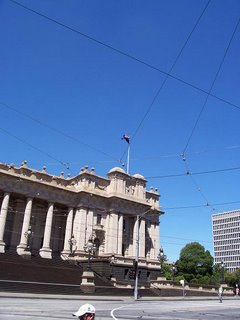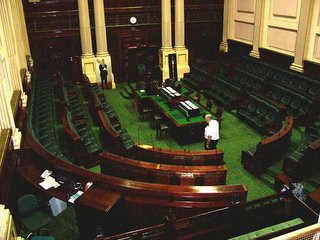
When my trip to Australia was still in the planning stages, I wondered whether I might be able to visit the national capital of Canberra. However, after looking at a map, I quickly realized that distances are as great in Australia as in North America and that it would be 6 hours driving distance from Melbourne. Obviously that would be impossible during such a brief visit. So, knowing that Melbourne is the capital of Victoria, Australia’s second-largest state, I requested of my hosts to be taken to visit the state parliament building in that city. Advance research indicated that parliament would not be sitting in January, when MLAs and MLCs would be on summer holidays. So I would be unable to see question time in the lower chamber. Nevertheless, even a visit to the buildings would be informative and likely to enrich my teaching of Canadian politics, given the similarities between the two countries’ constitutions.
Wednesday afternoon, the 18th, was designated free time for the Transforming Education conferees. Group tours were organized for wine-tasting (which quickly filled up) and riding Puffing Billy, Australia’s oldest functioning steam train. But Stuart Fowler had arranged through his MLA for a private tour for Ken Dickens and me of the Victorian Parliament building, which celebrates its 150th year in 2006. Because Ken lives in Sydney, neither of us knew Melbourne. However, I had purchased a map of the city, which helped us (eventually) to find our way into the central district.
We were a little late arriving at Parliament, mostly because my northern-hemispheric sense of direction didn’t serve me all that well in my unofficial role as Ken’s navigator. All the same, upon arrival, we didn’t have to wait but were greeted immediately by a bright young parliamentary clerk, who looked to be just under 30 years old and reminded me a great deal of one of my former students. Adding to this sense of familiarity, I was favourably impressed that, prior to our visit, he had taken the time to visit my websites to discover my research interests. As it turns out, he himself has a fascination for Canada, so we were able to compare notes between our respective countries’ political systems.
The Victorian Parliament, like those of four other Australian states, is a bicameral body, consisting of an upper chamber, the Legislative Council, and a lower chamber, the Legislative Assembly. Only Queensland has a unicameral parliament. Here in Canada, of course, all ten provincial legislatures are unicameral, Québec being the last to abolish its Conseil législatif in 1968, in an action eerily reminiscent of the opening volley of the French Revolution nearly two centuries earlier. (It even renamed its Legislative Assembly the National Assembly!) But because five of the six state parliaments are bicameral, they preserve more of the Westminster constitutional traditions, including the conventions of reading the Governor’s speech in the upper chamber and introducing money bills into the lower.

Even the internal layout of the two chambers reflects something of British parliamentary tradition. The Legislative Assembly, like the House of Commons, is predominantly green-coloured, while the Legislative Council, mirroring the House of Lords, is a red chamber. Nevertheless, although most parliamentarians face each other across the floor, the seats form a U at the end, as illustrated at left. Although the bottom of the U is often where members of minor parties sit, in the current parliament, with the Australian Labor Party holding an unprecedented 62 of 88 seats, the government benches extend around the U to the other side as well. The few Liberals and the even fewer Nats are crowded into the seats at the speaker’s immediate left.
I was surprised to learn, however, that, unlike British and Canadian practice, the state premier and the leader of the official opposition do not occupy the front benches of the Legislative Assembly. Rather both sit at a table in the middle of the floor facing each other across a row of law books, an arrangement perhaps intended to symbolize the rule of law in parliamentary government. The traditional Mace, carried by the Serjeant-at-Arms, lies between them at the other end of the table, perhaps as a way of keeping them from coming to metaphorical blows.

Between 1901, when the Commonwealth of Australia came into existence, and 1927, when Canberra became the federal capital, the federal Parliament met in this building, the House of Representatives and Senate occupying the two chambers. During this time the Victoria state parliament met in the Royal Exhibition Building several blocks to the north in Carlton Gardens. So the present parliament building has historic significance for the entire country, and not only for Victoria.
Between the two chambers lies Queen’s Hall. At one end stands a white statue of Queen Victoria, which, our guide informed us, is identical to the statue silently presiding over the interior of the Parliamentary Library in Ottawa. Victoria, of course, lent her name to the state, and references to “the Queen” abound in Australia’s constitution, which came into effect on 1 January 1901, exactly three weeks before her death.

Prior to my arrival in Australia, I discovered a fascinating anomaly in Australia’s relationship to the United Kingdom prior to the Australia Act 1986. When the Statute of Westminster was enacted, effectively recognizing the constitutional equality of the various “dominions” to the UK itself within the Empire/Commonwealth, there were a number of loose ends in these countries that would be tidied up only in the ensuing decades. In Canada, for example, until patriation in 1982, any change to the British North America Act, our chief constitutional document, required an act of the British Parliament, which Ottawa would have to request explicitly. In Australia, 1986 was the watershed year. After 1931 the appointment of a governor general by the reigning monarch would be on the advice of His Majesty’s ministers in Australia and not in Britain. However, due to an apparent oversight, the six Australian states remained in a position of technical subordination to Britain. State governors continued to be recommended by the Secretary of State for Commonwealth Relations in London, albeit with the input of the relevant state ministers. As J. D. B. Miller wrote nearly half a century ago:
In law, a State Governor could be ordered by the Commonwealth Relations Office to dissolve, or not to dissolve, his State parliament, or to refuse assent to a law passed by that parliament. In this sense the paradoxical situation exists of the British government being unable to interfere in the affairs of the Australian Federal government but able to interfere in those of the States.
This possibility was removed for good 20 years ago, after which time the relevant state ministers would advise the Queen whom to appoint as governor. (In Canada, of course, it is the Governor General in Council, i.e., the federal government, which appoints the provincial lieutenant governors.)
At the La Trobe University bookstore I purchased two books of relevance to the political system. The first is Australian Political Institutions, a standard undergraduate survey text. The second is Haig Patapan, Judging Democracy: The New Politics of the High Court of Australia, an analysis of the increasingly significant role of the High Court in shaping the domestic political process – a tendency very nearly universal in western constitutional democracies but which has nevertheless sparked severe criticism in those same countries.
Next: Antipodean sojourn VI: tying up loose ends.

No comments:
Post a Comment